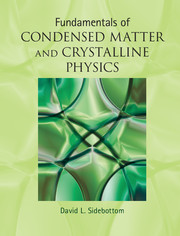 Fundamentals of Condensed Matter and Crystalline Physics
Fundamentals of Condensed Matter and Crystalline Physics Book contents
8 - Self-similar structures and liquid crystals
from Part II - Scattering
Published online by Cambridge University Press: 05 August 2012
Summary
Introduction
In this final chapter on the subject of scattering, we examine the structure of extended, but finite-sized composite objects constructed of a very large number of individual particles. Examples include polymer molecules composed of many repeated individual chemical units, and aggregation clusters that form when many individual particles randomly assemble into a larger structure. In both instances, we will see that the amorphous structures of these macroscopic-sized objects display self-similarity – a continuous hierarchy of structures that appear identical on many alternative length scales. This self-similarity appears in the pair distribution function as a power law dependence on radial distance, much unlike the sort of g(r) curves we have examined thus far, and which transforms into Fourier space as a corresponding power law variation of S(q).
Also in this chapter, we conclude our survey of structures and scattering with a brief look at liquid crystals and microemulsions, whose structures undergo a series of transitions with symmetries that are intermediate between that of crystals and liquids. In these materials the particles are able to spontaneously self-assemble into more ordered structures as a result of only weak, inter-particle forces.
- Type
- Chapter
- Information
- Fundamentals of Condensed Matter and Crystalline PhysicsAn Introduction for Students of Physics and Materials Science, pp. 109 - 136Publisher: Cambridge University PressPrint publication year: 2012


